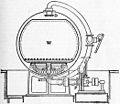
A kier, keir [1] or keeve (or similar spellings) is a large circular boiler or vat used in bleaching or scouring cotton fabric. They were also used for processing paper pulp.
Contents
In use they were continuously rotated by an engine, steam being supplied through a rotating joint in the axle. They were usually spherical, sometimes cylindrical, and some were recycled from old boiler shells. [2]




